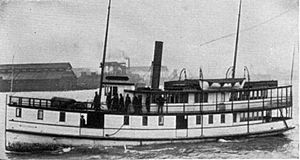Defiance (steamboat) facts for kids
The steamboat Defiance was an important ship that sailed the waters of Puget Sound in the early 1900s. It was part of what people called the "Puget Sound Mosquito Fleet," which was a large group of steamboats that carried passengers and goods around the many islands and towns of the Puget Sound area. Later in its life, this ship was known by a different name: Kingston.

Defiance (later Kingston)
|
|
Quick facts for kids History |
|
|---|---|
| Name | Defiance (Kingston) |
| Owner | McDowell Trans. Co.; others |
| Route | Puget Sound |
| Completed | 1901 |
| Out of service | 1933 |
| Fate | Wrecked. |
| General characteristics | |
| Tonnage | 91 |
| Length | 93 ft (28.3 m) |
| Installed power | steam engine; diesel in 1933 |
| Propulsion | propeller |
The Ship's Early Life
The Defiance was built in 1901. A man named Matthew McDowell built it in Tacoma. He built the ship to replace an older one called the Dauntless.
The Defiance was 93 feet long. It was designed to travel between Seattle, Tacoma, and the West Pass area. Other steamboats like the Glide and later the Virginia V also worked on this route.
Changing Owners and Names
Around 1913, the Defiance was sold. A company called the Kingston Transportation Company bought it. They decided to give the ship a new name: Kingston.
After its name change, the Kingston started a new route. It traveled between Ballard, Washington and Kingston.
Later Years as Kingston
By 1923, the Kingston had a new owner again. It was bought by the Whidby Island Transportation Company. This company was run by Captain F.G. Reeve. They also called themselves the Washington Route.
The Washington Route used the Kingston and another steamboat, the F.G. Reeve. They sailed from Seattle to places like Chico, Silverdale, and other spots on the Kitsap Peninsula and Bainbridge Island.
In the fall of 1923, Captain Reeve also put the Kingston and another ship, the Atalanta, on a route from Seattle to Coupeville.
The Final Journey
In 1932, the Washington Route sold the Kingston. Captain Charles West and some others bought the ship.
In 1933, the Kingston was changed from a steam-powered ship to a diesel-powered one. It was also fitted with special cold storage rooms. This was so it could carry goods in the trade routes of southeastern Alaska.
On May 20, 1933, the Kingston began its first trip north. Sadly, it was wrecked in the Whitestone Narrows, near Sitka. The ship was completely lost.

